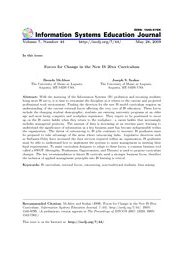Volume 7
Volume 7, Number 44 |
May 28, 2009 |
Abstract: With the maturing of the Information Systems (IS) profession and incoming students being more IS savvy, it is time to reexamine the discipline as it relates to the current and projected professional work environment. Finding the direction for the new IS model curriculum requires an understanding of the current external forces affecting the very core of IS education. These forces include the changing student demographic; students are entering university programs at an older age and most bring computer and workplace experience. They expect to be positioned to move up on the IS career ladder when they return to the workplace - a career ladder that increasingly includes managerial positions. The amount of data is increasing at an extreme pace; learning to understand the significance of information as a key business asset has become indispensable within the organization. The threat of outsourcing to IS jobs continues to increase; IS graduates must be prepared to take advantage of the areas where outsourcing lacks. Legislative directives such as Sarbanes-Oxley have increased the data services required within an organization; IS graduates must be able to understand how to implement the systems to assist management in meeting their legal requirements. To assist curriculum designers to adapt to these forces, a common business tool called a SWOT (Strengths, Weaknesses, Opportunities, and Threats) is used to propose curriculum changes. The key recommendation is future IS curricula need a stronger business focus, therefore the inclusion of applied management principles into IS learning is critical.
Keywords: IS curriculum, external forces, outsourcing, non-traditional students, data mining
Download this issue: ISEDJ.7(44).McAleer.pdf (Adobe PDF, 11 pages, 500 K bytes)
Preview the contents: McAleer.j.txt (ASCII txt, 33 K bytes)
Recommended Citation: McAleer and Szakas (2009). Forces for Change in the New IS 20xx Curriculum. Information Systems Education Journal, 7 (44). http://isedj.org/7/44/. ISSN: 1545-679X. (A preliminary version appears in The Proceedings of ISECON 2007: §3333. ISSN: 1542-7382.)
